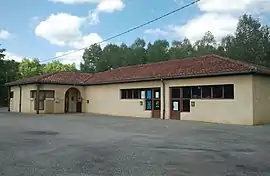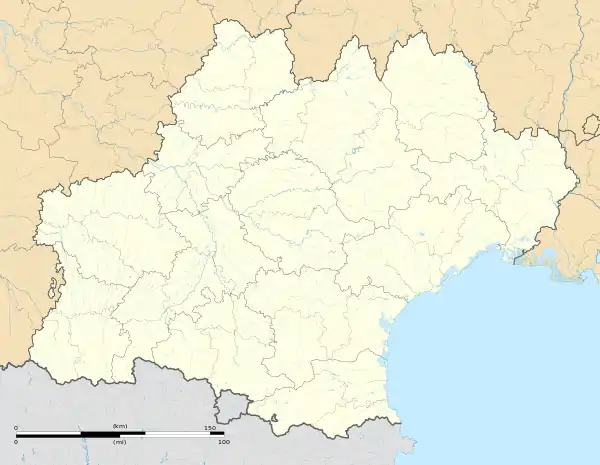Sansan | |
|---|---|
 The town hall in Sansan | |
Location of Sansan | |
 Sansan  Sansan | |
| Coordinates: 43°31′53″N 0°36′30″E / 43.5314°N 0.6083°E | |
| Country | France |
| Region | Occitania |
| Department | Gers |
| Arrondissement | Mirande |
| Canton | Auch-3 |
| Government | |
| • Mayor (2020–2026) | Jacques Sonilhac[1] |
| Area 1 | 3.7 km2 (1.4 sq mi) |
| Population | 97 |
| • Density | 26/km2 (68/sq mi) |
| Time zone | UTC+01:00 (CET) |
| • Summer (DST) | UTC+02:00 (CEST) |
| INSEE/Postal code | 32411 /32260 |
| Elevation | 159–240 m (522–787 ft) (avg. 166 m or 545 ft) |
| 1 French Land Register data, which excludes lakes, ponds, glaciers > 1 km2 (0.386 sq mi or 247 acres) and river estuaries. | |
Sansan (French pronunciation: [sɑ̃sɑ̃]) is a commune in the Gers department in southwestern France.
The vicinity of Sansan is known for its Miocene fossil deposits where geologist Edouard Lartet unearthed the jaw of the primate Pliopithecus antiquus in 1837.
Geography
Localisation
Sansan is located 14 km south of Auch and 4 km north of Seissan, along the Gers river.

Sansan and its surrounding communes
Toponymy
Sansan finds its origin in the Latin patronymic name Sancianus or Santius, followed by the suffix -anum, designing a property of which a man by this name must have been the owner in the times of Roman Gaul.[3]
Population
| Year | Pop. | ±% |
|---|---|---|
| 1962 | 87 | — |
| 1968 | 90 | +3.4% |
| 1975 | 81 | −10.0% |
| 1982 | 98 | +21.0% |
| 1990 | 108 | +10.2% |
| 1999 | 89 | −17.6% |
| 2008 | 93 | +4.5% |
See also
References
- ↑ "Répertoire national des élus: les maires" (in French). data.gouv.fr, Plateforme ouverte des données publiques françaises. 13 September 2022.
- ↑ "Populations légales 2021". The National Institute of Statistics and Economic Studies. 28 December 2023.
- ↑ Valdegers.fr
Wikimedia Commons has media related to Sansan.
This article is issued from Wikipedia. The text is licensed under Creative Commons - Attribution - Sharealike. Additional terms may apply for the media files.